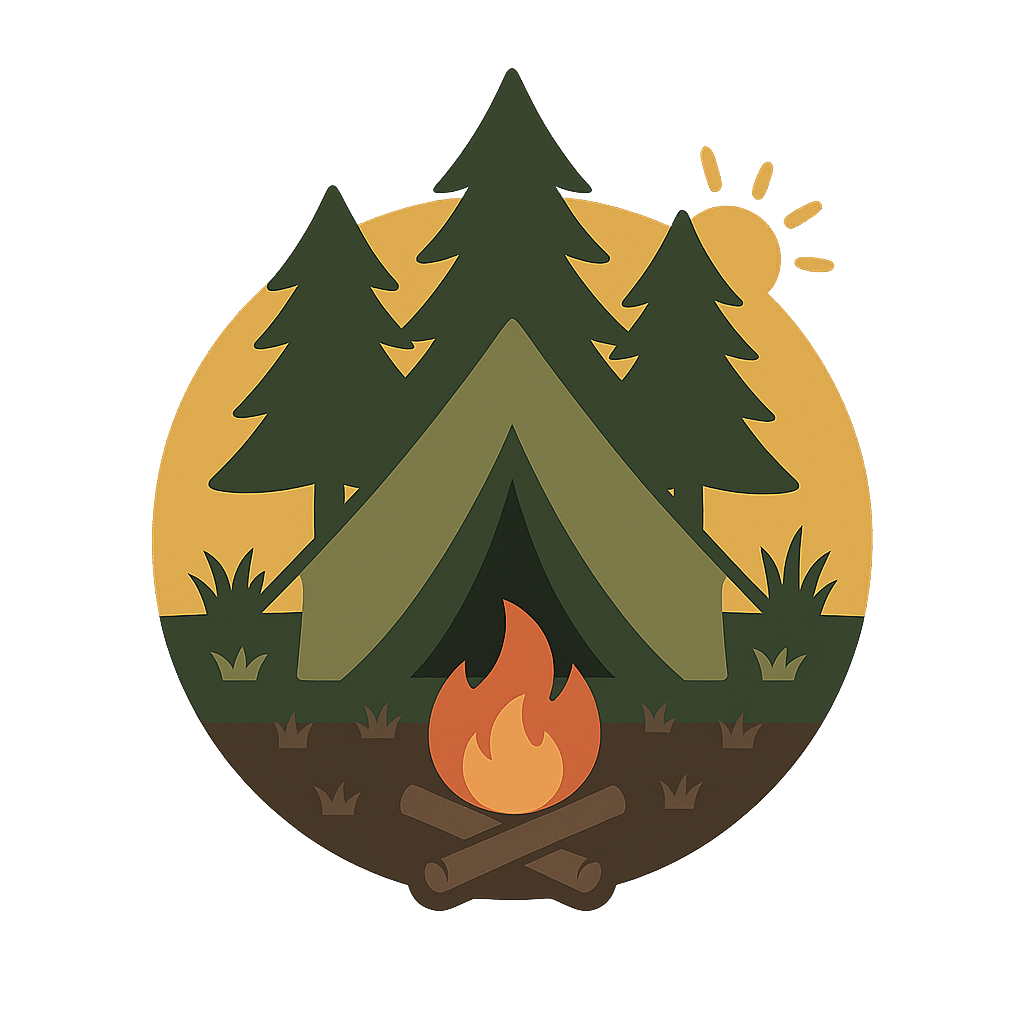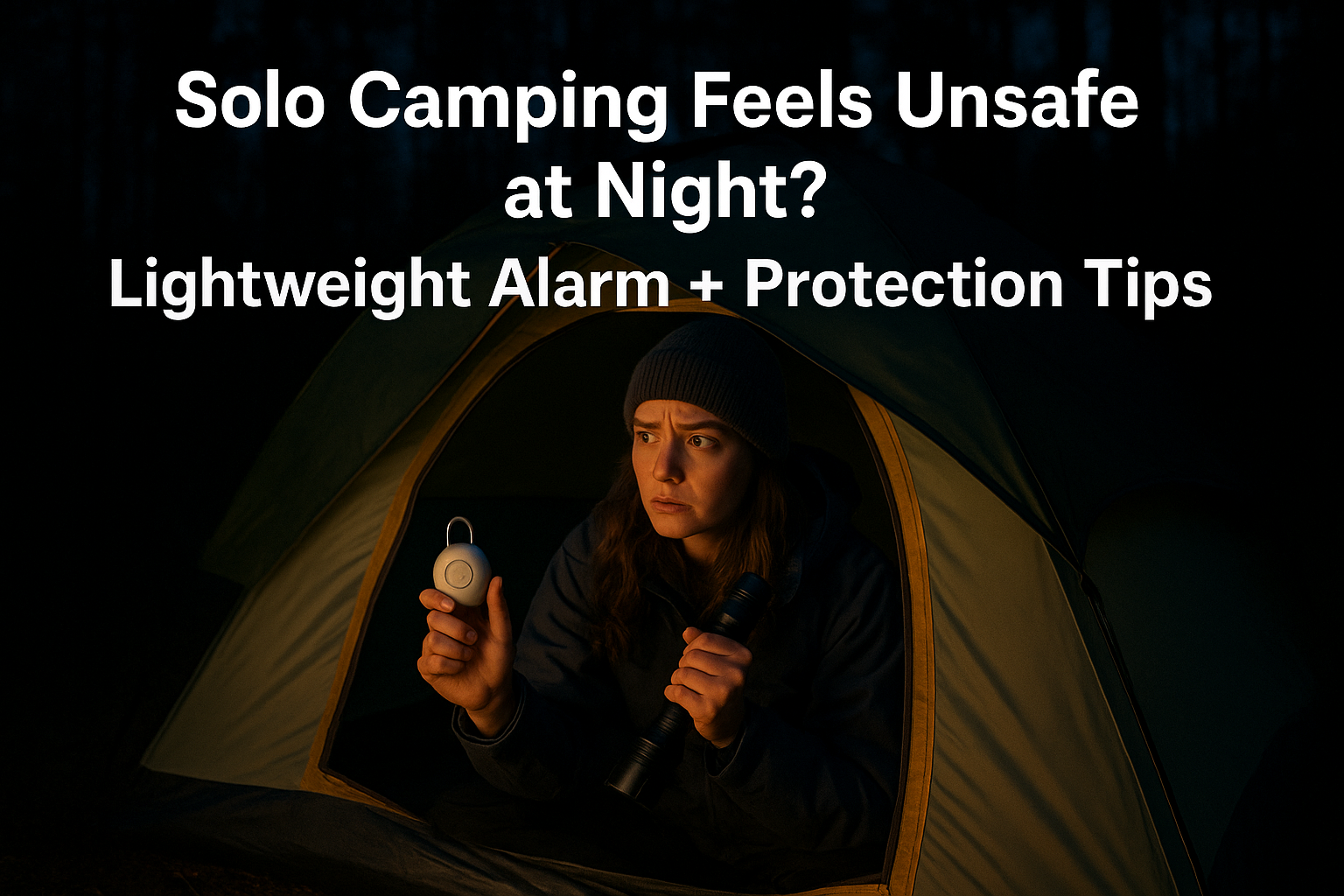As an Amazon Associate I earn from qualifying purchases.
The sun sets. The wind picks up. Every twig snap or distant animal call suddenly feels sharper. You’re alone, zipped into a nylon shelter with nothing but thin fabric between you and the unknown.
If you’ve ever struggled to sleep while solo camping—not because of your sleeping pad or the cold, but because you couldn’t stop scanning for threats—you’re not weak. You’re wired for survival.
Feeling unsafe at night while camping alone is one of the most common, yet least talked about, barriers to deeper wilderness adventures. The fear is real—but so are the lightweight solutions.
Whether your concern is wild animals, people, or just that eerie sense of exposure, this guide offers practical, ultralight alarm and protection strategies that help you rest easy without loading your pack like a prepper bunker.
Let’s turn that anxiety into awareness—and smart defense.
Why Night Feels So Unsafe When You’re Alone
At night, your senses go blind:
- You can’t see threats clearly
- Sounds get amplified and distorted
- You’re immobile once inside your tent
- There’s no one to take the second watch
These conditions awaken your primal survival instincts. But unlike your ancestors, you have tools. And unlike heavy self-defense gear, modern solo campers use clever setups that weigh less than a sandwich and provide peace of mind without overpacking.
Here’s how.
1. Perimeter Alarm Tripwire System (Under 3 oz)
You don’t need a military-grade tripwire to detect movement.
Build This:
- 20–30 ft of lightweight bank line or nylon cord
- 2–3 small jingle bells or fishing bells
- Optional: attach to a mini keychain alarm (90+ dB)
How It Works:
- String cord around your camp perimeter, ankle-high
- Tie bells at intervals or near tension points
- If triggered by a person, animal, or footstep, it alerts you instantly
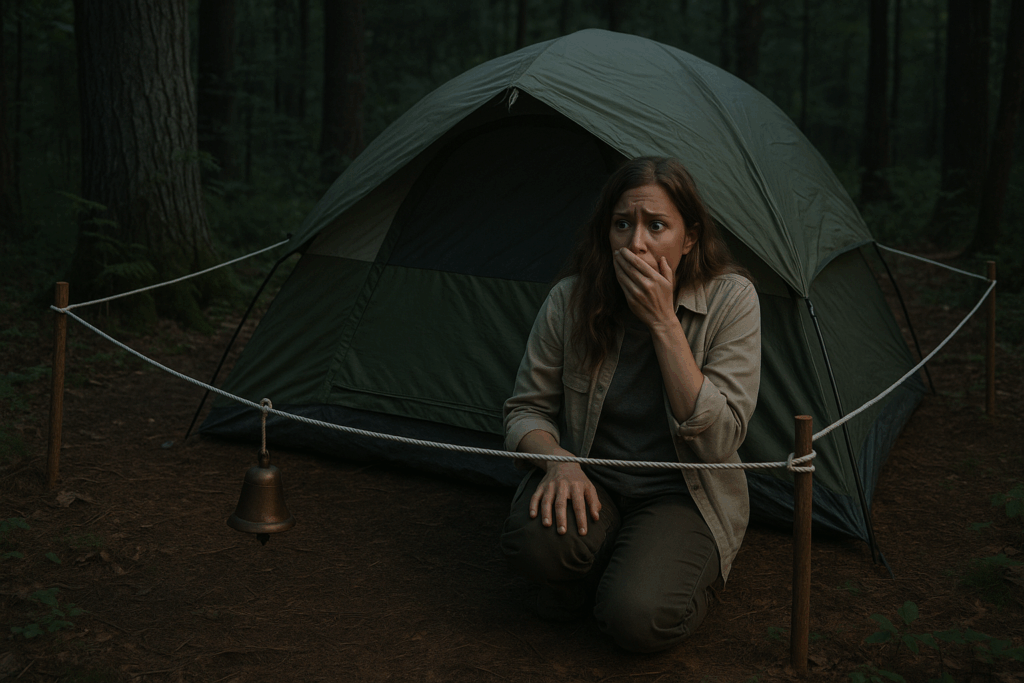
Pro Tip: Run the line between trees or bushes around 3–5 feet from your tent. Don’t trip yourself—set it wide enough to give you notice before something gets too close.
2. Keychain Personal Alarm (Under 2 oz, 120+ dB)
These are cheap, loud, and weigh nothing. Clip it to:
- Tent entrance zipper
- Your sleeping bag
- Your pack’s chest strap for fast grab-and-press access
When to Use:
- You hear someone/something approaching
- You’re being stalked
- You feel unsafe and want to draw attention fast
Bonus: The noise alone can startle animals, alert nearby campers, or buy time to get your pepper spray or headlamp.
SABRE Personal Alarm With Key Ring, 120dB Alarm, Audible Up To 1,280 Feet (390 Meters), Simple Operation, Reusable, Pink
- PERSONAL PROTECTION YOU CAN TRUST: SABRE is the #1 pepper spray brand trusted by police & consumers & a leader in the personal safety category.
- PERSONAL PROTECTION THAT SUPPORTS CHARITY: Ear-piercing 120dB siren is audible up to 1,280 feet (390 meters); Helps deter an attacker by attracting attention from those nearby. Proceeds benefit the National Breast Cancer Foundation (over $2 million donated so far!)
- EASY OPERATION: Simply pull the key ring to remove the pin to sound the alarm. Replace the pin to turn the alarm off. Reuse your personal alarm multiple times and no need to recharge thanks to the long-lasting battery.
List Price :
Offer: 10.29
Go to Amazon3. Whistle, Always Within Reach
It’s old-school for a reason.
Unlike electronic alarms, a whistle:
- Never runs out of batteries
- Works in rain, cold, or fog
- Alerts others (if nearby)
- Scares off some animals (especially if repeated sharply)
💡 Ultralight tip: Get a pea-less whistle made of plastic to avoid freezing or rust.
Clip it to your sleeping bag cord or tent zipper. Practice a signal blast (3 short, 1 long) if you’re traveling in areas with other campers.
4. Pepper Spray or Bear Spray – Mini Size Only
If you’re in bear country:
Use EPA-approved bear spray in a chest holster or near the tent flap. Don’t bury it in your pack.
For human or animal threats in other regions:
Use a mini 0.5 oz pepper spray keychain model. Some weigh under 1.5 oz and have 8–10 bursts.
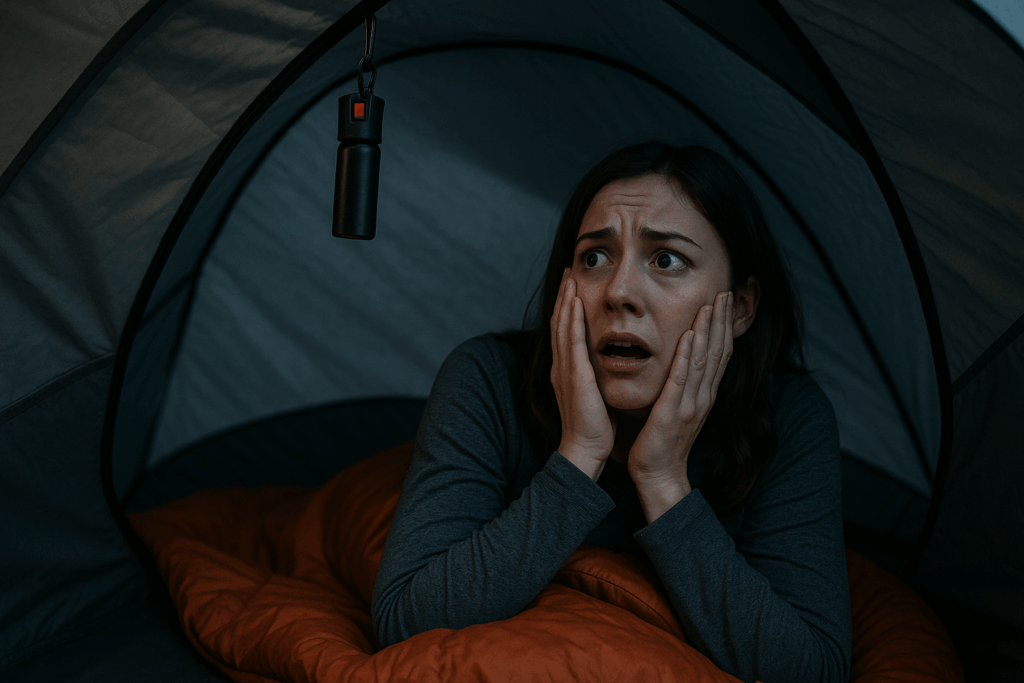
Important: Practice drawing and spraying. Sleep with it in a specific, consistent spot.
5. Headlamp with Red Mode + Strobe
Night blindness causes panic. You want a headlamp that:
- Turns on immediately
- Has a red mode (won’t kill your night vision)
- Can strobe or flash (to deter animals or alert rescuers)
Place it on a hook above your head. If you hear anything, turn it on before unzipping your tent.
Don’t waste time digging for it in your pack.
6. Silent Signal Setup: Leave a Trail
Let someone know where you are:
- Share GPS pin or planned route before your trip
- Leave a note in your vehicle at the trailhead with your ETA return
- For long trips: use a GPS beacon with “OK” check-in
This doesn’t help you sleep—but it helps you survive if something goes wrong. Your mind will rest easier knowing rescue is possible.
7. Camp With Visibility and Escape in Mind
Your camp layout matters more than you think. Even ultralight hikers should consider:
- Wide sightlines: Don’t sleep in brush or near blind curves
- Back to a barrier: Camp with your tent rear near a rock wall, downed log, or boulder to minimize exposure
- Escape route: Keep your shoes, headlamp, and jacket in the same place every night so you can exit fast
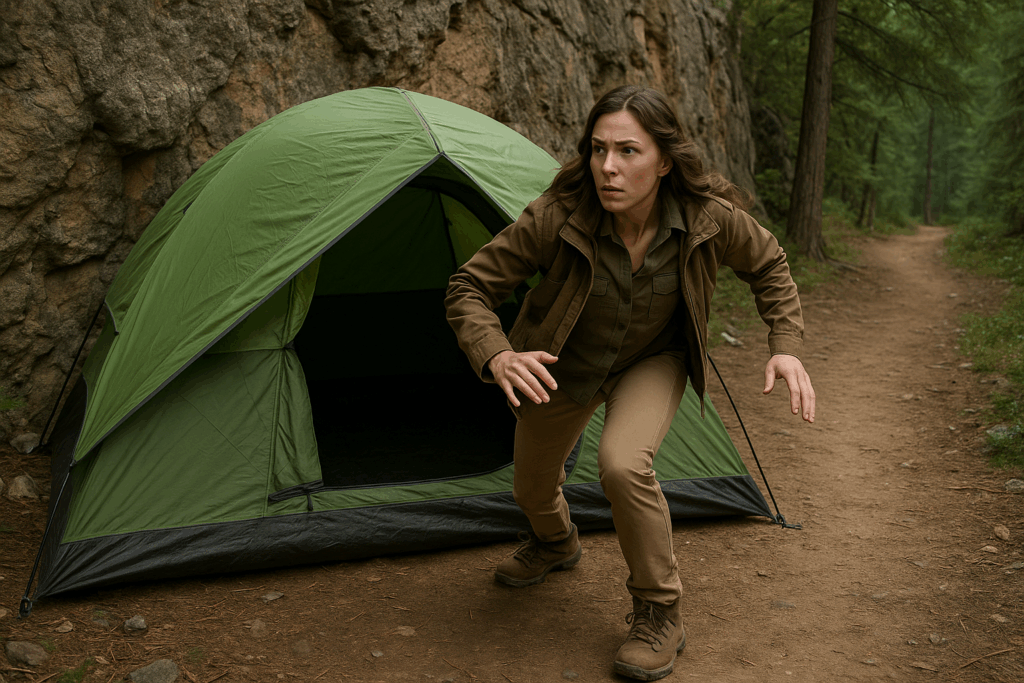
8. Make Yourself Seem Less Alone
Tricks to “Multiply” Yourself:
- Place extra shoes or pack outside your tent flap to imply a partner
- Tie up extra trekking poles as if another hiker is present
- Play low-volume human voices or music from your phone for a few minutes before bed (then shut off)
These psychological cues can deter humans with bad intentions or animals curious about small prey.
9. Leave No Scent Trails
Wild animals—especially raccoons, coyotes, and bears—are drawn to smell.
Ultralight Scent Safety:
- Double-bag all food in odor-proof bags
- Sleep with no scented items in tent (toothpaste, sunscreen, etc.)
- Use a bear hang or bear canister, even in non-bear country
- Wash hands after cooking—don’t sleep with greasy fingers
Don’t give animals a reason to come sniffing around in the dark.
10. Nighttime Mental Reset: The 3-Point Check
When anxiety spikes, run this loop:
- Scan: Any obvious movement, smells, or sounds? Use your headlamp to check.
- Grip: Touch your defense tools—whistle, spray, alarm. Confirm location.
- Breathe: In for 4, hold for 4, out for 6. Repeat until your heart rate slows.
You don’t need to eliminate fear—you just need to manage it.
This check turns panic into action, then calms the nervous system.
Final Thoughts: Don’t Fear the Night—Plan For It
Solo camping at night will never feel as safe as sleeping at home. And that’s okay.
The goal isn’t to silence your survival instincts—it’s to partner with them.
Using lightweight alarms, smart camp layout, and personal protection tools gives you a plan. And when you have a plan, fear shrinks.
You’ll still hear things. You’ll still feel that jolt when something rustles at 2AM. But you’ll know exactly what to do—and that confidence is worth more than any tent upgrade.
Because in the wild, peace of mind is protection.
✅ Quick Recap:
- Build a 3 oz perimeter alarm with bells or keychain devices
- Keep pepper spray, whistle, and light easily accessible
- Choose camp locations with visibility and backup exit routes
- Use headlamps with red light and strobe to disorient threats
- Hide solo status with decoys like extra shoes or poles
- Bag all scented items—don’t bring food smells to bed
- Reset your nervous system with a repeatable 3-step scan at night
